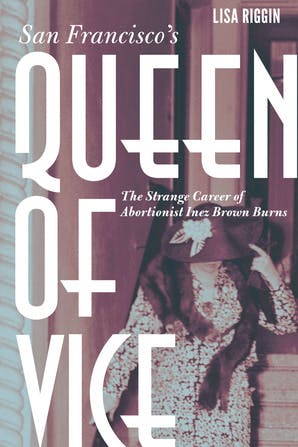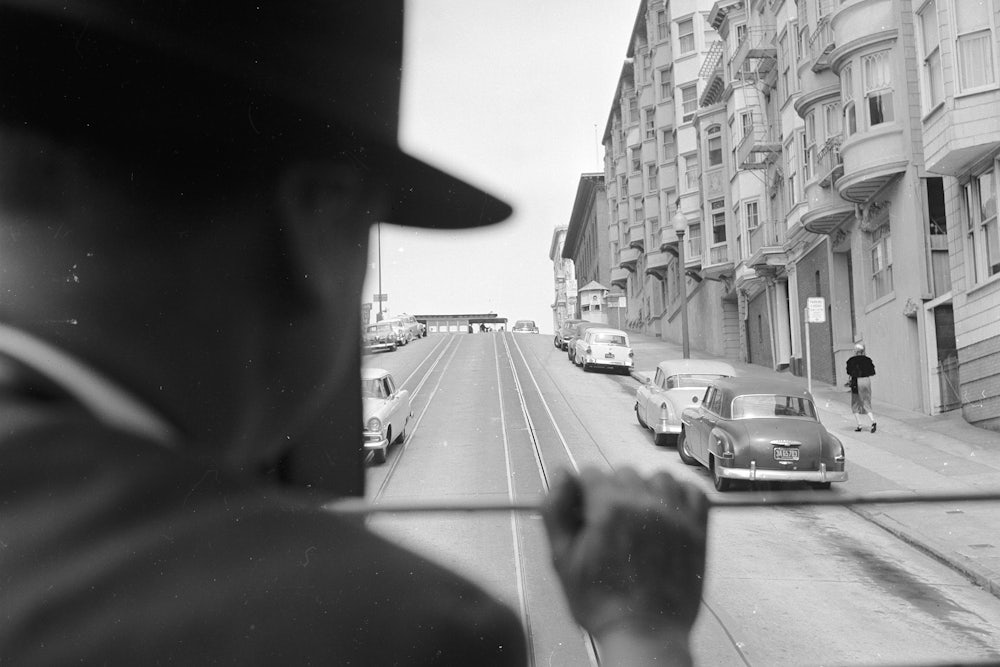When 17-year-old Inez Ingenthron needed an abortion, she turned to Dr. Eugene F. West, one of the customers who frequently sought out her escort services. West had made headlines in 1902, when he was charged with dismembering the body of a dead patient, and throwing her remains in San Francisco Bay. He claimed that the patient had died in his care as he attempted to remedy the injuries inflicted on her by another abortionist, and that he’d been forced to dispose of her body in this way. Though West was ultimately acquitted, his “incompetence and malpractice routinely kept him in the courtroom,” Dr. Lisa Riggin writes in her new book San Francisco’s Queen of Vice. But this didn’t make him particularly unusual. Not only did Inez make an appointment, but she also asked West to show her how the operation was performed.

Lisa Riggin’s subject in Queen of Vice is the woman who would eventually become known as Inez Brown Burns, the “abortion queen” of San Francisco. After her own experience, Burns quickly developed both an interest in abortions—“the simplicity of the procedure intrigued her,” Riggin writes—and a knack for performing them. Dr. West “recognized she was particularly talented as a surgeon—she had the ‘touch,’ he said, in her gentle hands and unwavering patience.” Overwhelmed by demand for abortions, he soon brought Burns on as a partner. For Burns, it was likely hard to imagine any other way that she, as a working class woman, could ever hope to practice surgery. And there was another advantage to providing abortions, one that became clear to her before she had performed a single procedure: “The fact,” Riggin notes, “that Dr. West made in one hour what took her weeks to earn.”
Burns opened her own clinic, and proved a success in nearly every way: In 35 years, hardly any of her patients suffered complications following abortion. If they did, and called Burns’s clinic, as they had been instructed, Burns placed them with an understanding, competent doctor, and paid for whatever additional care they needed—in cash. San Francisco authorities knew that the clinic—later described as a “mill”—took in staggering quantities of money every day, but few had any idea just how much. In a San Francisco Examiner interview published nearly a decade after the clinic closed in 1945, Burns said that she had made a million dollars a year, but that “nearly one half the take” went to bribes and payoffs. She paid out $125 a day plus a weekly tithing of $5,000 to the “brass downtown,” as well as a monthly “premium” of about $12,000 to the San Francisco police, and $5,000 “to every politician running for office.”
This was ostensibly Burns’s downfall. Abortion was the third-largest criminal enterprise in America, behind only gambling and narcotics (and ahead of prostitution). In 1940s San Francisco, Burns’s clinic, and Burns herself, became the focus of a highly publicized crackdown orchestrated by District Attorney Edmund G. “Pat” Brown, “who entered office,” Riggin notes, “pledging all his resources to ‘uproot the system’ of graft and corruption that ate away at the moral heart of the city—starting with the queen bee of them all.”
Today, we are used to anti-abortion rhetoric about “the sanctity of human life,” about “protecting the rights of the unborn,” and about the Bible’s teachings on prenatal development. (“Before I formed you in the womb, I knew you” is perhaps the Bible verse most frequently used in contemporary anti-abortion circles, although it specifically refers to God’s relationship with the prophet Jeremiah.) But in 1945, the case District Attorney Pat Brown made against Burns was based not on the fact that she performed abortions, but that she had done so illegally, and contributed to the city’s endemic organized crime and racketeering.
Gloria Shannon, a former employee at Burns’s clinic, wrote an exposé of Burns’s practices in an attempt to stoke moral outrage toward her (and to reap the financial gains that moral outrage tends to inspire). Shannon was, Riggin suggests, perhaps the first person to compare abortion to the atrocities of Nazi death camps, a comparison still often used today. Burns’s clinic, Shannon wrote, was filthy, and the sheets patients lay on during their procedures could go unchanged for over a week. Burns, Shannon claimed, did not disinfect her tools or her surgery room, and allowed towels to be washed only once they were soaked through with blood. But—at least according to Riggin’s account—Shannon’s article did not gain much traction. In fact, Shannon never even managed to get her whole story in print. After the first two installments appeared in the San Francisco Examiner on January 20 and 21, “eager readers picked up the paper on January 22” to find that “chapter three was missing without explanation.”
Nor did her account prove accurate. At Burns’s trial, testimony from the clinic’s other employees painted a markedly different picture than Shannon’s. Burns performed 20 to 40 abortions a day, they said, and meticulously sterilized her instruments after each procedure. She also kept a spotless surgery room, and displayed apparent concern about both the rare patients who experienced complications, and the frightened women and girls—some 187,500 of them in total, according to the prosecution’s estimate—who came to her for help. Burns’s clientele was primarily composed of the middle class and upper middle class women who could afford her services. (According to Burns’s granddaughter, both Rita Hayworth and Olympic figure skater Sonja Henie numbered among the clinic’s patients.) “I suppose everybody has known about that place for a long time,” a former client said when she took the stand.
Brown had the law on his side; what he didn’t have was a jury. At trial, Burns’s attorney—the gleefully state-baiting Walter McGovern—made the remarkable decision, Riggin writes, “not [to] call any witnesses or present any evidence at the trial; instead, he based his entire strategy and closing argument around establishing Burns’s operation as a ‘necessary evil,’ with the whole town in on the conspiracy.” A lone holdout refused to convict, and the jury, claiming they were hopelessly deadlocked, failed to arrive at a verdict. Two months later, in May 1947, Brown brought Burns to trial a second time, and a second jury failed to arrive at a unanimous verdict—though this time five jurors, rather than one, argued for acquittal. Only when Burns was tried a third time was she found guilty of practicing medicine without a license, and of “conspiracy to commit abortion.” She was sentenced to two to five years in prison.
With Burns in prison, other members of the “abortion racket” went to greater lengths to avoid the law, blindfolding or drugging women before whisking them away to secret clinics. And, once they saw a gap in the market, Riggin writes, “gangsters from Chicago and Brooklyn … had moved in” and began to run abortion clinics themselves. If Brown’s anti-abortion crusade was a crusade against organized crime, then he managed to fail on both counts.
Queen of Vice is a slender book that hews close to Burns’s legal struggles, but touches only lightly on the narrative’s historical, sociological, and legal contexts. It is the history of a prosecution, not a procedure. Riggin, who is a history professor at CSU Fullerton, assures the reader in the preface’s first lines that “this book does not examine the personal, social, or moral implications of abortion, nor is it a study of the women who underwent the procedure,” since “those accounts have been written.” But it is, of course, impossible to write a book about any aspect of abortion without touching on more questions than you can answer. Even Riggin’s framing can’t keep the “implications” of abortion itself, and the way Americans now regard it, out of the reader’s mind.
In 1946, authorities prosecuted Inez Brown Burns because her business enabled racketeering and corruption. But Riggin’s account demonstrates that Burns’s sins went beyond organized crime. She didn’t collect debts or smuggle narcotics or fence stolen goods. She gave women power over their own lives. In fact, she sold it to them—and the riches she earned this way gave her a degree of agency that the vast majority of American women could barely imagine, let alone reach for. Perhaps this alone made her so uniquely worthy of a district attorney’s feverish pursuit. Riggin’s book never once makes direct reference to the state of reproductive justice in 2017, but it is still impossible to read Queen of Vice without noting that Inez Brown Burns’s illegal clinic offered its patients better care—no transvaginal ultrasound, no mandatory waiting period, and full coverage of continued medical attention as needed—than most women can access today.
